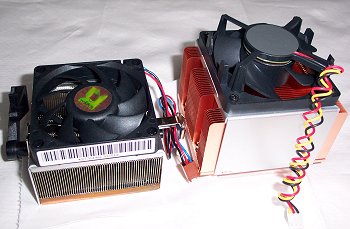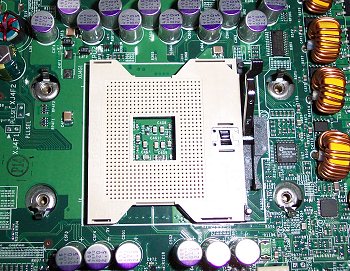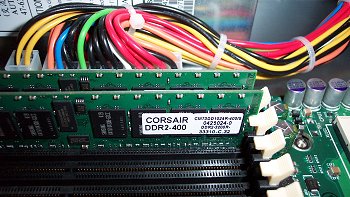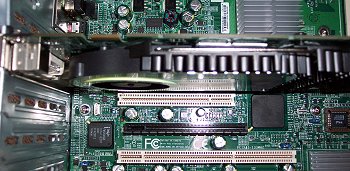Intel Nocona Xeon Test System
The Nocona test system was kindly supplied by Boston, a system integrator based in the U.K. that specialises in high performance computing.Based around a SuperMicro chassis and mainboard, the system came equipped as follows:
2 x 3.4GHz Intel Xeon 'Nocona' Processors (17 x 200, 1MB L2, HyperThreading)The black Supermicro chassis had a hot-swappable SATA disk enclosure capable of housing seven SATA drives. Cooled by a triplet of very loud fans (1 x 120mm, 2 x 80mm), it wasn't the last word in silent computing.
2GB of Corsair Registered ECC DDR-II PC2-3200 (2 x 1GB, 3-3-3-10, Samsung DRAMs)
Supermicro X6DAE-G2 Mainboard (dual-PGA603, dual-PEG16X, 8 DDR-II slots (16GB max), E7525 (Tumwater) + ICH5/R + PXH)
2 x Hitachi 400GB SATA 8MB cache Disks (HDS724040KLSA80)
NVIDIA GeForce 6800 GT 256MB PEG16X w/ dual-DVI
Supermicro Server Chassis
Pictures
You can see the heatsinks for the pair of Nocona processors on the right, with the octet of DDR-II DIMM slots beside them on the left. The 6800 GT sits in the first PEG16X slot. The disk enclosure is on the right, with the data cables connecting it to the mainboard very neatly clipped out of the way. Ignore the stray cable used to hookup a test disk.
The Opteron's cooler is on the right. Just kidding. Intel's Nocona Xeon, being based on the winter-warming Prescott core, is a toasty bit of silicon, requiring the use of a ~700g lump of copper and a not-so-quiet fan to cool it down. On the flip-side, the Opteron's cooler is small, light and the fan is speed controlled, making it very quiet in usual operation, even under load.
PGA603 isn't your average socket, looking a bit different from pretty much everything else out there.
Two sticks of Corsair's finest DDR-II PC2-3200 Registered 1GB DIMMs, gracing the uppermost of the eight DIMM slots.
Finally, you can see the 6800 GT nestling nicely in the uppermost PEG16X slot, with the second slot crying out for another 6800 GT, the little connecting adaptor and some 65.xx driver loving. Try as I might, extorting the connector out of NVIDIA proved futile.














